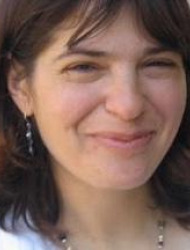
Welcome to the next PoreLab lecture!
Who: Einat Aharonov, Professor at the Institute of Earth Sciences at the Hebrew University of Jerusalem
Professor Aharonov’s research group studies coupled physical and chemical processes that control deformation and evolution of rocks. Most of her research focuses on how relatively small-scale processes (on the pore, grain, or asperity scale) control large-scale geological phenomena such as soil liquefaction, the dynamics of landslides and earthquakes, the process of rock compaction/dissolution, or the physics of friction. Her group also studies larger scale coupled deformation, such as coupled brittle – ductile deformation, the creation of pockmarks on the ocean floor, salt tectonics and the physics of subduction initiation. She works on the boundary between physics and geology, using mainly theoretical and numerical tools. However, her work is always constrained by observations: to understand the physics of a system of interest, she collaborates also with field geologists and experimentalists who provide an empirical foundation to the theoretical work.
When: Wednesday 16 October at 13:00 (Norway time)
Where: The lecture will be in-person in the Kelvin room (PoreLab Oslo) and will be streamed in the common room (PoreLab Trondheim). From anywhere else, you will be able to join via the following Zoom link:
https://uio.zoom.us/j/65837085049?pwd=WjZianUyN3FJa2liQkxBbzQrOCtGdz09
Title: The importance of seepage forces in soil-liquefaction
Abstract:
Shahar Ben-Zeev, Einat Aharonov, Liran Goren, Renaud Toussaint.
Soil liquefaction is a widespread and destructive earthquake-induced process. During liquefaction, soils that have reliably supported buildings and bridges for years, liquify under seismic shaking, becoming a soup in which buildings sink, and bridges collapse. The traditional explanation for liquefaction suggests an undrained response, where shaking increases pore pressure as fluid-filled soil pores collapse too quickly for fluid to escape, transferring load from soil grains to pore fluid. However, the undrained model cannot fully explain many common observations: i) liquefaction observed far from the earthquake main-shock (under low seismic energy). ii) liquefaction events that recur in a single location and iii) phenomena like co-seismic fluid expulsion and soil settlement.
We used a physics-based model of pore pressure evolution in deforming granular layers, along with numerical simulations and shaking table experiments, to demonstrate that pore fluid pressurization can also occur through a drained process, not only through the undrained mechanism. The term “drained” refers here to situations where pore pressure dissipates faster than grains rearrange during shaking. Under these conditions, fluid drains upward as the grains settle, exerting “seepage forces” on grains. In drained liquefaction, seepage force, i.e. the pressure gradient force, and not the pressure itself, liquefies the soil. The dynamics are governed by an upward-moving compaction front, which separates a compacted, non-liquefied layer at the base from a settling liquefied layer at the top. The front speed and the degree of layer compaction depend on the rate of seismic energy input.
We show that drained liquefaction is induced even under low seismic energy input, offering an explanation for the puzzling observation that most liquefaction events occur beyond the earthquake’s near-field. The front dynamics and the relation between degree of compaction and seismic energy also explain recurring liquefaction events, which occur despite natural processes expected to prevent such repeated liquefaction. Practically, our study impacts the very methodology of seismic hazard predictions, finding that well-drained soil (i.e. soils with high permeability), areas that experience mild shaking, and soils that have previously liquefied, may need to be considered as hazardous.
